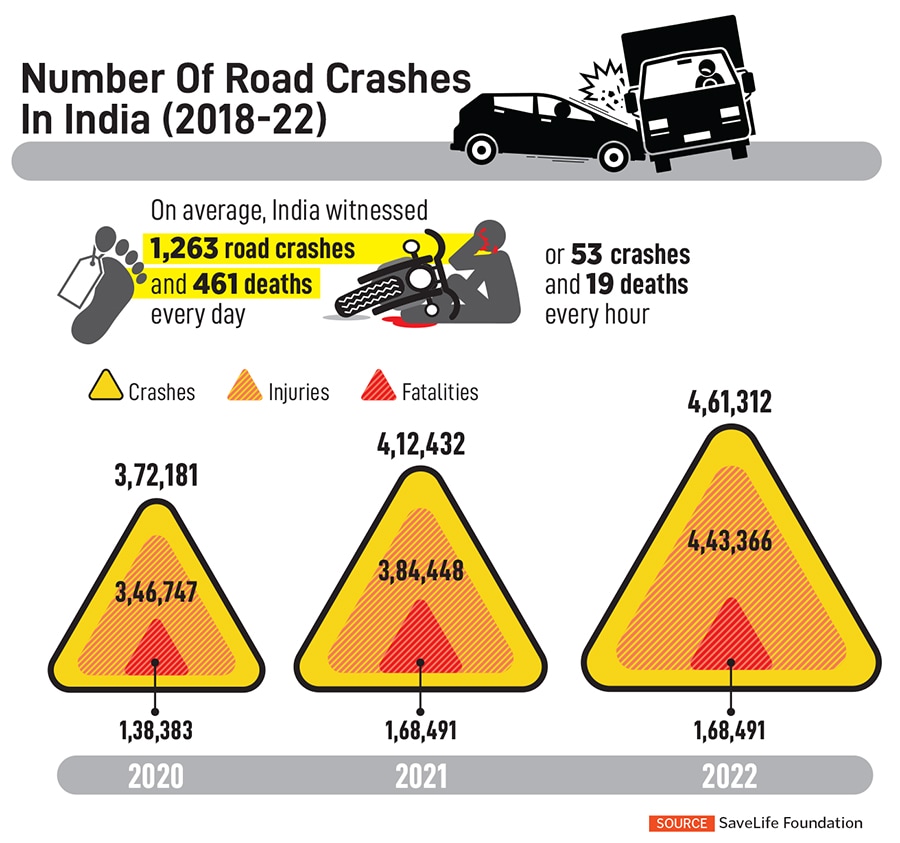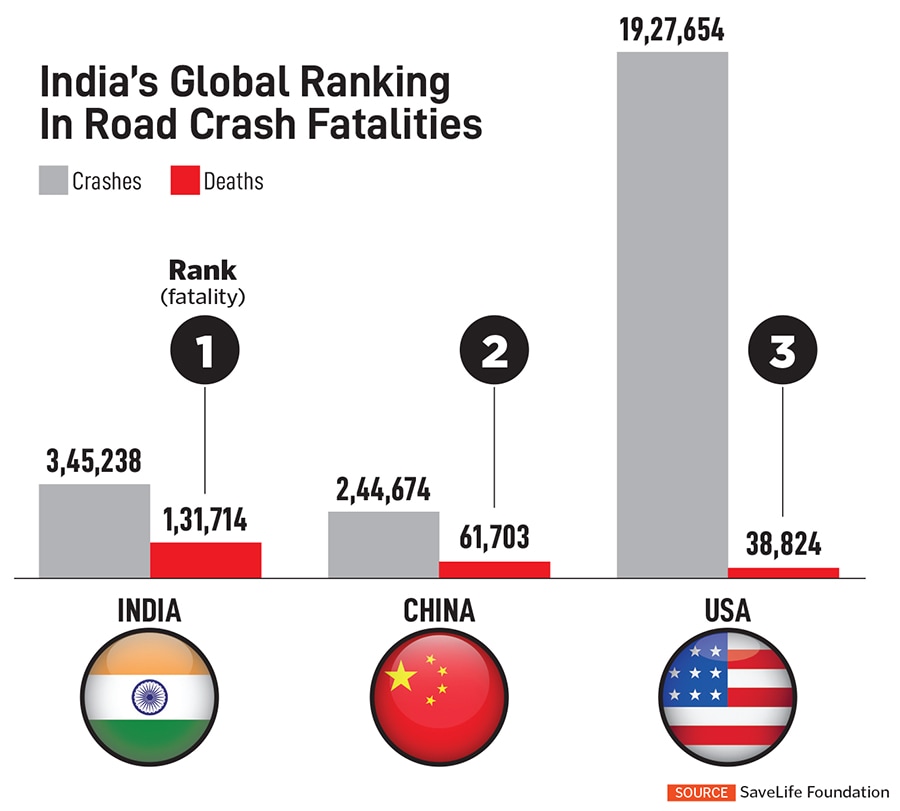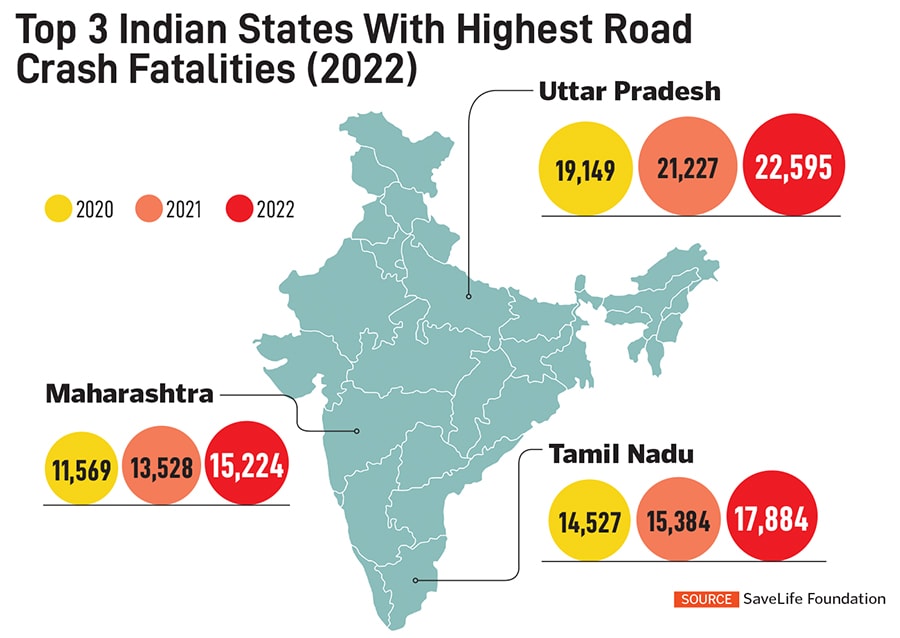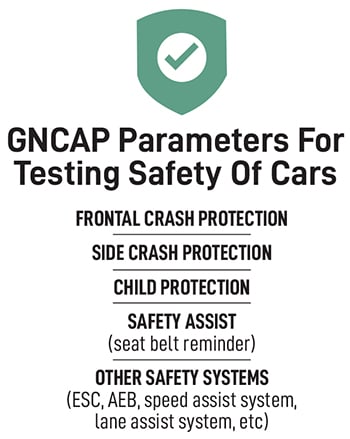How safe are the cars you are driving on Indian roads?
India's speed limits are touching 100km for highways and expressways but safety ratings for passenger vehicles in India are given after conducting crash tests at a maximum speed of 64 kmph


Expressways in India have speed limits of 120 kmph for passenger vehicles. Highways have speed limits of 100 kmph. Car speedometers show that the vehicle can be driven at maximum speeds of between 180 kmph and 220 kmph (depending on the car model). But safety ratings for passenger vehicles in India are given after conducting crash tests at a maximum speed of 64 kmph.
There is some rationale behind keeping the speed of crash tests at 64 kmph, as explained by industry veterans later in this article, but the information itself seems to be a footnote—if at all—in the sales pitch that most car buyers get from sales personnel at car showrooms, or even the data sheets available on the websites of rating agencies.
India has the highest number of road crash fatalities in the world (see box), and most of them on national and state highways where drivers were speeding (see box). There is a pressing need to make safety information of vehicles more readily accessible to consumers, while also raising mass awareness about the need to follow driving rules and guidelines in order to avoid crashes, fatalities and injuries.
India’s Ministry of Road Transport and Highways introduced the BNCAP (Bharat New Car Assessment Programme) in October 2023, in collaboration with Global NCAP, thus becoming the fifth nation in the world to adopt such a safety system. Although the BNCAP testing parameters are broadly based along the existing GNCAP parameters, there are differences between the two with regard to the rating categories and types of crash tests. Also, GNCAP is a private entity, funded by different car companies and charitable organisations, while BNCAP is a government entity.

As of now, the programme is voluntary in nature. Carmakers can choose to send their vehicles for testing, or not, while also choosing to disclose the ratings of those to customers, or not. This July, BNCAP also introduced stickers that car manufacturers can display on their vehicles, with details about their safety ratings and other information.
Ironically enough, one of the reasons behind bringing about a standard safety rating system for passenger vehicles in India is to increase the salability of these vehicles in export markets. India’s passenger vehicle exports stood at 180,483 units in the first quarter of FY25, registering a jump of 19 percent in the same period last year, according to data from the Society of Indian Automobile Association (Read, ‘Made in India, sold worldwide’).

So why are cars tested for an offset frontal crash at a speed of 64 kmph? Industry veterans explain this by highlighting the differences between test conditions and real-life road conditions.
Rahul Bharti, executive director, corporate affairs, Maruti Suzuki India Limited, explains how consumers can reconcile these two pieces of information—that the speed limit of highways and expressways are between 100 and 120 kmph, while crash-test speeds are a maximum of 64 kmph—and what they should be doing about it. “A test condition of 64 kmph simulates almost a speed of 2x, on actual roads. This is because in case of a real collision, the energy of the impact is absorbed by two bodies. In the test lab, the vehicle is driven against a fixed barrier, and so the entire energy is taken up by the car alone. There are NHTSA research papers on the same."
Elaborating on this explanation, Mohan Savarkar, chief product officer of Tata Motors, says, statistically, it’s not as if someone would knowingly crash their car at the highest possible speed. Generally, the driver is able to anticipate that a collision is going to take place and take evasive action or braking action or both. “Statistics show that even if the road speeds are, say, 100 kmph or more than that, when you brake or take evasive action, if your car is okay for an offset frontal crash at 64 kmph, it takes care of many eventualities [in the event of a real-life crash]," he says.
Side impacts are normally not as severe as frontal impacts, he adds, because these take place when the car is skidding and is out of control, and hits a pole or other barrier. “At that time, your speed reduces even more, and the [side impact] test is normally done at 50 kmph," he says.

However, there are other real-life factors that can often be different from controlled test conditions. “The tests are normally against a stationary object, and on the road you may not find everything stationary. So, to some extent it helps if the other car is also compliant, in the sense if both cars happen to be, say, five-star rated and then there is a collision, there’s a very good likelihood that both people will benefit from it," he says.
“But, if there is, say, a stationary vehicle on the side of the road, then the conditions of the test that we’re doing are closer to what is likely to happen on the road as well." If there is, say, a disparate difference in the weights and the inertias of the two vehicles or two objects that are colliding, then there will be something in between the first two situations.

Till a few decades ago, whether or not a car was safe for its occupants was judged by the amount of material that was used to build its frame, body and interiors. However, the kind of material and technology that was available at that time could also cause grievous or even fatal injuries to car occupants in the case of certain kinds of accidents. Cars could also cause serious injuries to other, more vulnerable road users, such as pedestrians, cyclists and two-wheeler riders. The concept of safety has since evolved, thanks to newer materials and technology, and software like computer-aided engineering.
Savarkar says, “Just a few years ago, it would have been okay to just make your car stronger and stronger, like a battle tank. But now when we speak of safety, one aspect is about what happens to people inside the car, another is about what happens to other vulnerable road users. We need to take care of all these things with the features we provide. The first step, of course, is how not to get into a crash at all."
He explains that, first and foremost, consumers need to ensure their car is safe to drive at speed limits such as 100 kmph or above. “At a basic level, the car should have ABS, and at a slightly more evolved level called ESP. This helps keep control of the car at high speeds, if there’s a turning on the road or an unexpected object or vehicle that appears in fog conditions and you want to take an evasive action," he adds.
The materials used in a car to absorb the crash also have to be such that they are strong enough not to buckle easily, while having properties that enable the car to absorb a lot of energy on its own or through aids like crumple zones that are provided in front of the car.
“Many people feel that car bumpers appear flimsy and buckle even under a slight pressure by hand. It is meant to be that way. So, when you encounter a low-speed crash, say with a person on the road, this feature avoids injury to the person. Let’s say the head of a person comes and hits the bonnet. The bonnet should also give, and provide for lower injury to the person," Savarkar explains.
 (Anti-clockwise from top) Electromagnetic interference compatibility tests being conducted on Maruti vehicles, Maruti Suzuki tests its vehicles for high-speed banking, and on low-friction tracks
(Anti-clockwise from top) Electromagnetic interference compatibility tests being conducted on Maruti vehicles, Maruti Suzuki tests its vehicles for high-speed banking, and on low-friction tracks
The Tata Harrier and Safari received 5-star ratings from GNCAP last year, and were given the Safer Choice Award by the global safety ratings body this September. Tata’s electric variant of the Punch became the first electric vehicle (EV) in India to get the 5-star rating from BNCAP this June, followed by the Nexon EV, which also got a 5-star rating from BNCAP.
In September, Maruti Suzuki dominated the list of highest selling cars in India, with seven cars in the list of top 10. The Ertiga was the highest selling model, followed by the Swift. “Maruti has submitted three cars for BNCAP testing. We are waiting for the result to come any time. Of course, we are hopeful of a good score. We have sent the Grand Vitara, the Baleno, and the Brezza," says Bharti.
He elaborates that the safety features that the company provides include ABS, which is now standard, electronic brake force distribution, and electronic stability programme, 360 degree-view cameras, heads-up display, day and night adjustable inner rear-view mirrors, seat belt height adjusters and seat belt reminders. “We have been giving customers the option [to choose variants with multiple airbags]. From June 2023, all new models launched have six airbags as standard. We provide drivers with a good line of sight, with a higher front seat height adjuster so that it improves visibility, and hill hold assist, which are useful even while using ramps at, say, parking areas in malls," he says.

Saurabh Vatsa, managing director of Nissan Motor India, says the company’s current Magnite model, which was launched in 2020, includes features such as vehicle dynamic control, traction control system, hill start assist, hydraulic brake assist, ABS, electronic brake-force distribution, tyre pressure monitoring system, and SRS dual airbag system with pretension, load limiter seatbelt and crash locking tongue for driver and passenger.
The Nissan Magnite had received a 4-star rating for adult occupants and a 2-star rating for child occupants in 2022 from GNCAP.
With the launch of the new Magnite facelift in October in India, Nissan has included more than 55 active and passive safety features, which is complemented with an improved body structure, which has 67 percent advanced and high tensile strength steel. Six airbags and rear parking sensors are now standard across all variants, and Nissan has introduced a high mount stop lamp that flashes for emergency braking to warn the vehicles in the rear. “Split seats with ISOFIX ensure that child seats are securely fastened, adding extra safety for younger passengers. Moreover, the rear 3-point seat belts and seat belt reminders for all occupants [again standard across all trims and variants] ensures that even rear seat passengers are protected during sudden stops or potential impacts," adds Vatsa.

“There is no such thing as an accident." While that statement might bring to mind the character of Oogway, from the 2008 film Kung Fu Panda, it is now being said by Piyush Tewari, founder and CEO of SaveLife Foundation. “An accident is something that is unavoidable. We refer to these incidents as crashes, like the aviation industry does. This is because each of these incidents could have been avoided, if everyone was following the rules and if everything was working the way they should." Tewari highlights several reasons behind road crashes in India. Chief among them are speeding, driving on the wrong side, drunk driving, use of mobile phones while driving and jumping red lights.
Veteran industry leaders also highlight issues such as not wearing seat belts as one of the main reasons behind fatalities and grievous injuries caused to the occupants of a car in the event of a crash.
“Safety is a comprehensive subject and depends on several parameters, on the engineering of the road and the engineering of the car. The biggest thing it depends on is the safe conduct of the person driving the vehicle," says Bharti of Maruti Suzuki. “If you don’t fasten your seatbelt, no amount of engineering of the car can save you. Seat belts are more important for the rear seats because in the front you are able to see an impending accident and have time to react in the rear seat, your view is blocked by the front seats and you don’t get any reaction time."
 Tewari further explains that a rear-seat passenger who is not wearing a seat belt is like an 80-kg projectile being hurled at the front seats from behind in the case of a front or rear collision. “This can cause serious injuries not just to the rear passenger, but also to the driver and front passenger," he adds.
Tewari further explains that a rear-seat passenger who is not wearing a seat belt is like an 80-kg projectile being hurled at the front seats from behind in the case of a front or rear collision. “This can cause serious injuries not just to the rear passenger, but also to the driver and front passenger," he adds.
According to Bharti, 79 percent of casualties among car inmates were not wearing seatbelts. “To a very large extent, almost all of these could have been prevented if the seatbelt was fastened," he rues. He adds that on highways, the phenomenon of driving in the wrong direction is catastrophic. “In very modern expressways, sometimes the signages might be confusing, and if a person makes an error, they try to compensate for it by driving on the wrong side of the carriageway. This has to stop."
Lucknow-based Prateek Singh, a YouTuber who has been posting videos on his eponymous channel since 2020 with an aim to raise awareness around the factors behind road crashes and road rage incidents, says speeding is the biggest factor behind crashes. “A lot of people, especially in the age group of 25 to 30, want to make videos and Instagram reels of driving at high speeds," he says, based on the crash incidents that he has investigated for his channel.
Videos of cars being driven well above speed limits (with the camera often focussed on the speedometer) are common on social media platforms. While all of them do not result in accidents or fatalities, some do. In August, an influencer called Rajat Dalal’s video of him reportedly speeding at 140 kmph through a road that had a substantial amount of traffic and hitting (and driving past) a biker had gone viral. In July, two people were killed when their speeding car hit a crash barrier in Nagpur the occupants, including the driver, were reported to have been recording Instagram reels inside the moving vehicle.
Tewari and Singh both also highlight road design and conditions that contribute to crashes and fatalities. Tewari adds that, in all the road crash incidents that SaveLife Foundation has investigated and analysed, he has found that the construction of roads and road furniture (essential elements that are placed along modern highways and expressways, such as guard rails, signages, lights, etc) have also been factors behind crashes.
 “Along highways or expressways, there are metal guardrails placed alongside the carriageway," says Singh. “The point at which the guardrail begins or terminates, the end of the rails are supposed to be covered with a flat sheet of metal, so that no car actually hits the sharp end of the rails, but hits the flat metal surface instead."
“Along highways or expressways, there are metal guardrails placed alongside the carriageway," says Singh. “The point at which the guardrail begins or terminates, the end of the rails are supposed to be covered with a flat sheet of metal, so that no car actually hits the sharp end of the rails, but hits the flat metal surface instead."
He adds that these requirements are often not followed by those who construct the roads, and cars are known to have crashed into the guardrails, which then ploughed through car’s interiors, grievously injuring the occupants.
Singh also mentions rumblers that are not built to specifications, thus causing vehicles to bounce dangerously at high speeds, even while within speed limits. “It is ultimately the responsibility of the government to ensure that rules and regulations are followed while building such high-speed roads."
Singh has just registered his NGO Road Sense Welfare Foundation, to raise awareness about safer driving, and is also about to launch his brand of dash-cam, which he feels can be an essential aid in safer driving.
Although cars are apparently getting safer, and carmakers are improving their safety features, Tewari mentions some sobering facts. In India, the vast majority of people travel on highways not in cars, but in buses, and there are no safety regulations and requirements in place for the drivers of these vehicles or their occupants. “Anybody can buy the chassis of the bus and build a body on it, which is essentially made of aluminium sheets and wooden planks. There are no safety features whatsoever," he rues.
Drivers of such buses are also very often overworked, drive with little sleep, and do not have the luxury of the basic safety-related technology, while passengers don’t even have seat belts, let alone any other safety equipment. “It is time that safety regulations were put in place for this category of highway users as well," says Tewari.
First Published: Oct 21, 2024, 14:32
Subscribe Now